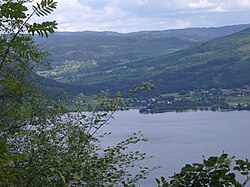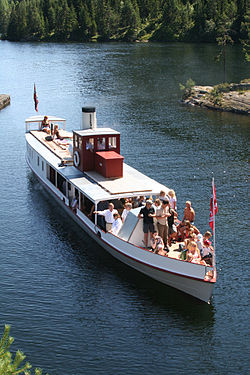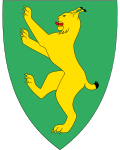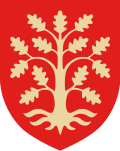Bygland
 From Wikipedia - Reading time: 14 min
From Wikipedia - Reading time: 14 min
Bygland Municipality
Bygland kommune | |
|---|---|
 View of Bygland | |
|
| |
 Agder within Norway | |
 Bygland within Agder | |
| Coordinates: 58°55′27″N 07°45′53″E / 58.92417°N 7.76472°E | |
| Country | Norway |
| County | Agder |
| District | Setesdal |
| Established | 1 Jan 1838 |
| • Created as | Formannskapsdistrikt |
| Administrative centre | Bygland |
| Government | |
| • Mayor (2023) | Runar Flåt Granheim (Ap) |
| Area | |
• Total | 1,311.75 km2 (506.47 sq mi) |
| • Land | 1,150.35 km2 (444.15 sq mi) |
| • Water | 161.40 km2 (62.32 sq mi) 12.3% |
| • Rank | #76 in Norway |
| Population (2023) | |
• Total | 1,136 |
| • Rank | #323 in Norway |
| • Density | 1.0/km2 (3/sq mi) |
| • Change (10 years) | |
| Demonym | Byglending[1] |
| Official language | |
| • Norwegian form | Nynorsk |
| Time zone | UTC+01:00 (CET) |
| • Summer (DST) | UTC+02:00 (CEST) |
| ISO 3166 code | NO-4220[3] |
| Website | Official website |
Bygland is a municipality in Agder county, Norway. It is located in the traditional district of Setesdal. The administrative centre of the municipality is the village of Bygland. Other villages in the municipality include Åraksbø, Austad, Byglandsfjord, Grendi, Langeid, Lauvdal, Litveit, Longerak, Moi, Ose, Sandnes, Skåmedal, and Tveit. The Norwegian National Road 9 runs through the municipality, following the river Otra where most of the population of Bygland lives.

The 1,312-square-kilometre (507 sq mi) municipality is the 76th largest by area out of the 356 municipalities in Norway. Bygland is the 323rd most populous municipality in Norway with a population of 1,136. The municipality's population density is 1 inhabitant per square kilometre (2.6/sq mi) and its population has decreased by 5.9% over the previous 10-year period.[4][5]
General information
[edit]

The parish of Bygland was established as a municipality on 1 January 1838 (see formannskapsdistrikt law). Since that time, the municipal boundaries have not changed.[6]
Name
[edit]The municipality (originally the parish) is named after the old Bygland farm (Old Norse: Byggland) since the first Bygland Church was built there. The first element is bygg which means "barley". The last element is land which means "land" or "farm".[7]
Coat of arms
[edit]The coat of arms was granted on 15 November 1991. The official blazon is "Vert, a lynx rampant Or langued gules and the tips of ears and tail sable" (Norwegian: På grøn grunn ei oppspringande gull gaupe). This means the arms have a green field (background) and the charge is a European lynx (Lynx lynx) with a red tongue and with the tips of ears and tail being black. The lynx has a tincture of Or which means it is commonly colored yellow, but if it is made out of metal, then gold is used. The green color in the field symbolizes the importance of the agriculture and forests in the municipality. The lynx was chosen to symbolize the wild and rich nature in the rural highlands of the municipality. The arms were designed by Daniel Rike. The municipal flag has the same design as the coat of arms.[8][9][10][11][12]
Churches
[edit]The Church of Norway has two parishes (sokn) within the municipality of Bygland. It is part of the Otredal prosti (deanery) in the Diocese of Agder og Telemark.
| Parish (sokn) | Church name | Location of the church | Year built |
|---|---|---|---|
| Bygland | Austad Church | Tveit | 1880 |
| Bygland Church | Bygland | 1838 | |
| Sandnes Church | Åraksbø | 1844 | |
| Årdal | Årdal Church | Grendi | 1828 |
Geography
[edit]
Bygland lies in the middle of the Setesdal valley which is also a traditional district in Aust-Agder county. The valley includes the municipalities of Bykle, Valle, Bygland, Iveland, and Evje og Hornnes. The Otra river flows from the glacially scoured Hardangervidda plateau in the north, through the Setesdal valley (and through Bygland), and into the sea near the city of Kristiansand. The municipality is bordered on the north by Valle, in the east by Fyresdal (Telemark county) and Åmli (Agder county), in the south by Froland and Evje og Hornnes, and in the west by Åseral, Kvinesdal, and Sirdal (all in Agder county).
Bygland is Agder's third largest municipality in area. The majority of the area of the municipality lies in the Setesdalsheiene mountains, at an elevation of over 700 metres (2,300 ft) above sea level. The municipality stretches from the small town Byglandsfjord in the south to the farms at Langeid in the north. Lake Byglandsfjorden is 40 kilometres (25 mi) long and lies on the river Otra. Other lakes include the Åraksfjorden, Gyvatn, Hovatn, Kvifjorden, Longerakvatnet, Straumsfjorden, and Topsæ. The rivers Otra and Topdalsfjorden both run through Bygland on their way south. The Reiårsfossen waterfall is one of many waterfalls in the municipality.
Climate
[edit]Byglandsfjord is situated inland in the southernmost of Norway's main valleys and has a humid continental climate (Dfb) or temperate oceanic climate (Cfb), depending on winter threshold used (0 °C (32 °F) as in USA or −3 °C (27 °F) as in Europe). The precipitation pattern, with autumn and winter as wettest seasons, is in line with an oceanic climate. The all-time high 33.7 °C (92.7 °F) was recorded in July 1986. The all-time low −31 °C (−24 °F) is from January 1941. The coldest low after 1980 is −23.6 °C (−10.5 °F) recorded February 1986. The average date for the last overnight freeze (low below 0 °C (32.0 °F)) in spring is 3 May[13] and average date for first freeze in autumn is 14 October[14] giving a frost-free season of 163 days (1981-2010 average).
| Climate data for Byglandsfjord 1991-2020 (212 m, precipitation days 1961-90, extremes 1919-2020 includes earlier stations) | |||||||||||||
|---|---|---|---|---|---|---|---|---|---|---|---|---|---|
| Month | Jan | Feb | Mar | Apr | May | Jun | Jul | Aug | Sep | Oct | Nov | Dec | Year |
| Record high °C (°F) | 11.7 (53.1) |
13.4 (56.1) |
18.4 (65.1) |
24.4 (75.9) |
29.4 (84.9) |
32.1 (89.8) |
33.7 (92.7) |
31.7 (89.1) |
25.4 (77.7) |
20.7 (69.3) |
15.9 (60.6) |
12.3 (54.1) |
33.7 (92.7) |
| Mean daily maximum °C (°F) | 1 (34) |
1 (34) |
5 (41) |
11 (52) |
15 (59) |
20 (68) |
21 (70) |
20 (68) |
16 (61) |
10 (50) |
5 (41) |
2 (36) |
11 (51) |
| Daily mean °C (°F) | −1.3 (29.7) |
−1.7 (28.9) |
0.7 (33.3) |
5 (41) |
10 (50) |
14.1 (57.4) |
16.3 (61.3) |
15.3 (59.5) |
11.4 (52.5) |
6.4 (43.5) |
2.6 (36.7) |
−0.2 (31.6) |
6.6 (43.8) |
| Mean daily minimum °C (°F) | −3 (27) |
−4 (25) |
−2 (28) |
1 (34) |
5 (41) |
10 (50) |
12 (54) |
12 (54) |
9 (48) |
5 (41) |
2 (36) |
−1 (30) |
4 (39) |
| Record low °C (°F) | −31 (−24) |
−27.5 (−17.5) |
−22.6 (−8.7) |
−19.9 (−3.8) |
−7.1 (19.2) |
−2.8 (27.0) |
0.6 (33.1) |
−0.8 (30.6) |
−5.7 (21.7) |
−11 (12) |
−16.2 (2.8) |
−20.1 (−4.2) |
−31 (−24) |
| Average precipitation mm (inches) | 149 (5.9) |
94 (3.7) |
84 (3.3) |
71 (2.8) |
86 (3.4) |
96 (3.8) |
100 (3.9) |
130 (5.1) |
136 (5.4) |
162 (6.4) |
153 (6.0) |
144 (5.7) |
1,405 (55.4) |
| Average precipitation days (≥ 1.0 mm) | 15 | 11 | 12 | 8 | 10 | 9 | 10 | 11 | 12 | 14 | 15 | 14 | 141 |
| Source 1: eklima/Norwegian Meteorological Institute[15] | |||||||||||||
| Source 2: weatheronline[16] | |||||||||||||
History
[edit]
The Setesdal Line was a narrow-gauge steam railway which went between Vennesla and Byglandsfjord in Bygland. It was built in 1896. The Setesdal Line's operation was terminated in 1962 and the track was removed between Byglandsfjord and Beihølen.
Other transport up the Setesdal valley was provided by the steamships SS Bjoren and Dølen. First placed in operation in 1866, the SS Bjoren is still in operation as a tourist attraction on lake Byglandsfjorden during the summers.
Government
[edit]Bygland Municipality is responsible for primary education (through 10th grade), outpatient health services, senior citizen services, welfare and other social services, zoning, economic development, and municipal roads and utilities. The municipality is governed by a municipal council of directly elected representatives. The mayor is indirectly elected by a vote of the municipal council.[17] The municipality is under the jurisdiction of the Agder District Court and the Agder Court of Appeal.
Municipal council
[edit]The municipal council (Kommunestyre) of Bygland is made up of 15 representatives that are elected to four year terms. The tables below show the current and historical composition of the council by political party.
| Party name (in Nynorsk) | Number of representatives | |
|---|---|---|
| Labour Party (Arbeidarpartiet) | 4 | |
| Conservative Party (Høgre) | 6 | |
| Pensioners' Party (Pensjonistpartiet) | 1 | |
| Centre Party (Senterpartiet) | 4 | |
| Total number of members: | 15 | |
| Party name (in Nynorsk) | Number of representatives | |
|---|---|---|
| Labour Party (Arbeidarpartiet) | 4 | |
| Conservative Party (Høgre) | 4 | |
| Centre Party (Senterpartiet) | 4 | |
| Setesdal List (Setesdalslista) | 3 | |
| Total number of members: | 15 | |
| Party name (in Nynorsk) | Number of representatives | |
|---|---|---|
| Labour Party (Arbeidarpartiet) | 3 | |
| Centre Party (Senterpartiet) | 5 | |
| Joint list of the Conservative Party (Høgre) and the Liberal Party (Venstre) | 4 | |
| Bygland local list (Bygland Bygdeliste) | 3 | |
| Total number of members: | 15 | |
| Party name (in Nynorsk) | Number of representatives | |
|---|---|---|
| Labour Party (Arbeidarpartiet) | 3 | |
| Centre Party (Senterpartiet) | 5 | |
| Joint list of the Conservative Party (Høgre) and the Liberal Party (Venstre) | 3 | |
| Bygland local list (Bygland Bygdeliste) | 4 | |
| Total number of members: | 15 | |
| Party name (in Nynorsk) | Number of representatives | |
|---|---|---|
| Labour Party (Arbeidarpartiet) | 2 | |
| Christian Democratic Party (Kristeleg Folkeparti) | 2 | |
| Centre Party (Senterpartiet) | 4 | |
| Joint list of the Conservative Party (Høgre) and the Liberal Party (Venstre) | 2 | |
| Bygland local list (Bygland Bygdeliste) | 5 | |
| Total number of members: | 15 | |
| Party name (in Nynorsk) | Number of representatives | |
|---|---|---|
| Labour Party (Arbeidarpartiet) | 2 | |
| Christian Democratic Party (Kristeleg Folkeparti) | 2 | |
| Centre Party (Senterpartiet) | 6 | |
| Bygland local list (Bygland Bygdeliste) | 5 | |
| Total number of members: | 15 | |
| Party name (in Nynorsk) | Number of representatives | |
|---|---|---|
| Labour Party (Arbeidarpartiet) | 4 | |
| Conservative Party (Høgre) | 2 | |
| Christian Democratic Party (Kristeleg Folkeparti) | 2 | |
| Centre Party (Senterpartiet) | 7 | |
| Total number of members: | 15 | |
| Party name (in Nynorsk) | Number of representatives | |
|---|---|---|
| Labour Party (Arbeidarpartiet) | 6 | |
| Conservative Party (Høgre) | 2 | |
| Christian Democratic Party (Kristeleg Folkeparti) | 2 | |
| Centre Party (Senterpartiet) | 5 | |
| Total number of members: | 15 | |
| Party name (in Nynorsk) | Number of representatives | |
|---|---|---|
| Labour Party (Arbeidarpartiet) | 5 | |
| Conservative Party (Høgre) | 2 | |
| Christian Democratic Party (Kristeleg Folkeparti) | 2 | |
| Centre Party (Senterpartiet) | 4 | |
| Liberal Party (Venstre) | 2 | |
| Total number of members: | 15 | |
| Party name (in Nynorsk) | Number of representatives | |
|---|---|---|
| Labour Party (Arbeidarpartiet) | 8 | |
| Conservative Party (Høgre) | 3 | |
| Christian Democratic Party (Kristeleg Folkeparti) | 3 | |
| Centre Party (Senterpartiet) | 5 | |
| Liberal Party (Venstre) | 2 | |
| Total number of members: | 21 | |
| Party name (in Nynorsk) | Number of representatives | |
|---|---|---|
| Labour Party (Arbeidarpartiet) | 8 | |
| Conservative Party (Høgre) | 4 | |
| Christian Democratic Party (Kristeleg Folkeparti) | 3 | |
| Centre Party (Senterpartiet) | 5 | |
| Liberal Party (Venstre) | 1 | |
| Total number of members: | 21 | |
| Party name (in Nynorsk) | Number of representatives | |
|---|---|---|
| Labour Party (Arbeidarpartiet) | 8 | |
| Conservative Party (Høgre) | 3 | |
| Christian Democratic Party (Kristeleg Folkeparti) | 3 | |
| Centre Party (Senterpartiet) | 7 | |
| Total number of members: | 21 | |
| Party name (in Nynorsk) | Number of representatives | |
|---|---|---|
| Labour Party (Arbeidarpartiet) | 7 | |
| Christian Democratic Party (Kristeleg Folkeparti) | 4 | |
| Centre Party (Senterpartiet) | 10 | |
| Total number of members: | 21 | |
| Party name (in Nynorsk) | Number of representatives | |
|---|---|---|
| Labour Party (Arbeidarpartiet) | 9 | |
| Christian Democratic Party (Kristeleg Folkeparti) | 3 | |
| Centre Party (Senterpartiet) | 8 | |
| Liberal Party (Venstre) | 1 | |
| Total number of members: | 21 | |
| Party name (in Nynorsk) | Number of representatives | |
|---|---|---|
| Labour Party (Arbeidarpartiet) | 10 | |
| Christian Democratic Party (Kristeleg Folkeparti) | 2 | |
| Centre Party (Senterpartiet) | 7 | |
| Liberal Party (Venstre) | 2 | |
| Total number of members: | 21 | |
| Party name (in Nynorsk) | Number of representatives | |
|---|---|---|
| Labour Party (Arbeidarpartiet) | 11 | |
| Christian Democratic Party (Kristeleg Folkeparti) | 2 | |
| Centre Party (Senterpartiet) | 6 | |
| Liberal Party (Venstre) | 2 | |
| Total number of members: | 21 | |
| Party name (in Nynorsk) | Number of representatives | |
|---|---|---|
| Labour Party (Arbeidarpartiet) | 9 | |
| Christian Democratic Party (Kristeleg Folkeparti) | 3 | |
| Centre Party (Senterpartiet) | 7 | |
| Liberal Party (Venstre) | 2 | |
| Total number of members: | 21 | |
| Party name (in Nynorsk) | Number of representatives | |
|---|---|---|
| Labour Party (Arbeidarpartiet) | 9 | |
| Christian Democratic Party (Kristeleg Folkeparti) | 3 | |
| Farmers' Party (Bondepartiet) | 7 | |
| Liberal Party (Venstre) | 2 | |
| Total number of members: | 21 | |
| Party name (in Nynorsk) | Number of representatives | |
|---|---|---|
| Labour Party (Arbeidarpartiet) | 8 | |
| Christian Democratic Party (Kristeleg Folkeparti) | 2 | |
| Farmers' Party (Bondepartiet) | 8 | |
| Liberal Party (Venstre) | 2 | |
| Total number of members: | 20 | |
| Party name (in Nynorsk) | Number of representatives | |
|---|---|---|
| Labour Party (Arbeidarpartiet) | 9 | |
| Christian Democratic Party (Kristeleg Folkeparti) | 2 | |
| Farmers' Party (Bondepartiet) | 4 | |
| Joint List(s) of Non-Socialist Parties (Borgarlege Felleslister) | 5 | |
| Total number of members: | 20 | |
| Party name (in Nynorsk) | Number of representatives | |
|---|---|---|
| Labour Party (Arbeidarpartiet) | 11 | |
| Farmers' Party (Bondepartiet) | 2 | |
| Joint List(s) of Non-Socialist Parties (Borgarlege Felleslister) | 7 | |
| Total number of members: | 20 | |
| Party name (in Nynorsk) | Number of representatives | |
|---|---|---|
| Labour Party (Arbeidarpartiet) | 9 | |
| Farmers' Party (Bondepartiet) | 6 | |
| Liberal Party (Venstre) | 1 | |
| Joint list of the Conservative Party (Høgre) and the Liberal Party (Venstre) | 3 | |
| Local List(s) (Lokale lister) | 1 | |
| Total number of members: | 20 | |
| Note: Due to the German occupation of Norway during World War II, no elections were held for new municipal councils until after the war ended in 1945. | ||
Mayors
[edit]The mayors (Norwegian: ordfører) of Bygland:[39]
- 1838–1841: C.A. Münster
- 1841–1851: Andreas Møglestue
- 1851–1863: Gunstein Grundeson Frøyrak
- 1863–1866: Gunstein Jørundson Langerak
- 1866–1869: Daniel Grundeson Aakhus
- 1869–1879: Gunnar Olavson Nese
- 1879–1887: Olav Grundeson Aakhus
- 1887–1889: Tarald Bjørgulvson Langeid
- 1889–1902: Lars Knutson Liestøl (V)
- 1902–1908: Aasulv Lande
- 1908–1911: Tarkjel K. Austad
- 1911–1914: Aasulv Lande
- 1914–1917: Olav T. Nordgaren
- 1917–1923: Aanund O. Langerak
- 1923-1929: Knut O. Sandnes
- 1929–1935: Jørund Kvaale (Bp)[40]
- 1935-1941: Nere Aakhus (V)
- 1941-1942: Olav Ottar Abusdal (NS)
- 1942-1945: Gunnar Heistein (NS)
- 1945-1945: Gunnar Lande
- 1945-1947: Hallvard Lidi
- 1947-1958: Jørund Kvaale (Bp)[40]
- 1958–1959: Osmund Faremo (Ap)
- 1960-1963: Tarkjel Langerak
- 1963–1966: Osmund Faremo (Ap)
- 1966–1968: Hallvard Frøysnes (Ap)
- 1968-1972: Gunnar Gakkestad (Sp)
- 1972–1985: Knut P. Sandnes (Sp)
- 1985–1987: Magnhild Rygg (Sp)
- 1988-1991: Sigbjørn Horverak (KrF)
- 1992-1995: Torbjørn Borgi (Ap)
- 1995–2011: Knut A. Austad (Sp)
- 2011–2019: Leiv Rygg Langerak (Sp)
- 2019–2023: Sigbjørn Åge Fossdal (Ap)
- 2023-present: Runar Granheim (Ap)[41]
Attractions
[edit]
- Byglandsfjord Station, a former railway station constructed in 1896
- SS Bjoren, a wood-fuelled heritage steamboat that travels the route between Byglandsfjord-Bygland and Bygland-Ose on the lake Byglandsfjorden in the summer.
- Bygland tower, a folk museum.
Notable people
[edit]- Even Torkildsen Lande (1758 in Bygland – 1833), a Norwegian farmer and blacksmith who served on the Norwegian Constitutional Assembly
- Oscar Castberg (1846 in Bygland – 1917), a Norwegian painter and sculptor
- Hallvard Sandnes (1893 in Sandnes - 1968), a Norwegian schoolteacher and writer
- Olav Bø (1918 in Bygland – 1998), a Norwegian folklorist
- Kjell Kristian Rike (1944 in Byglandsfjord – 2008), a Norwegian sports commentator
References
[edit]- ^ "Navn på steder og personer: Innbyggjarnamn" (in Norwegian). Språkrådet.
- ^ "Forskrift om målvedtak i kommunar og fylkeskommunar" (in Norwegian). Lovdata.no.
- ^ Bolstad, Erik; Thorsnæs, Geir, eds. (9 January 2024). "Kommunenummer". Store norske leksikon (in Norwegian). Foreningen Store norske leksikon.
- ^ Statistisk sentralbyrå. "Table: 06913: Population 1 January and population changes during the calendar year (M)" (in Norwegian).
- ^ Statistisk sentralbyrå. "09280: Area of land and fresh water (km²) (M)" (in Norwegian).
- ^ Jukvam, Dag (1999). Historisk oversikt over endringer i kommune- og fylkesinndelingen (PDF) (in Norwegian). Statistisk sentralbyrå. ISBN 9788253746845.
- ^ Rygh, Oluf (1905). Norske gaardnavne: Nedenes amt (in Norwegian) (8 ed.). Kristiania, Norge: W. C. Fabritius & sønners bogtrikkeri. p. 204.
- ^ "Civic heraldry of Norway - Norske Kommunevåpen". Heraldry of the World. Retrieved 19 January 2023.
- ^ "Bygland, Aust-Agder (Norway)". Flags of the World. Retrieved 19 January 2023.
- ^ "Godkjenning av våpen og flagg". Lovdata.no (in Norwegian). Norges kommunal- og arbeidsdepartementet. 15 November 1991. Retrieved 19 January 2023.
- ^ "Kommunevåpenet" (in Norwegian). Bygland kommune. Retrieved 23 April 2017.
- ^ "Bygland kommune, våpen". Digitalarkivet (in Norwegian). Arkivverket. Retrieved 10 July 2023.
- ^ "Siste frostnatt om våren". 4 May 2012.
- ^ "Første frostnatt". 25 September 2013.
- ^ "eklima portal". Archived from the original on 31 March 2016. Retrieved 20 June 2021.
- ^ "Weatheronline".
- ^ Hansen, Tore; Vabo, Signy Irene, eds. (20 September 2022). "kommunestyre". Store norske leksikon (in Norwegian). Kunnskapsforlaget. Retrieved 14 October 2022.
- ^ "Kommunestyrevalg 2023 - Agder". Valgdirektoratet. Retrieved 28 January 2024.
- ^ "Kommunestyrevalg 2019 – Agder". Valgdirektoratet. Retrieved 19 January 2023.
- ^ "Kommunestyrevalg 2015 - Aust-Agder". Valgdirektoratet.
- ^ a b c d "Table: 04813: Members of the local councils, by party/electoral list at the Municipal Council election (M)" (in Norwegian). Statistics Norway.
- ^ "Kommunestyrevalg 2011 - Aust-Agder". Valgdirektoratet.
- ^ Kommunestyrevalget 1999 (PDF) (in Norwegian). Oslo-Kongsvinger, Norge: Statistisk sentralbyrå. 2000. ISBN 8253748531. ISSN 0332-8023.
- ^ Kommunestyrevalget 1995 (PDF) (in Norwegian). Oslo-Kongsvinger, Norge: Statistisk sentralbyrå. 1996. ISBN 8253743351. ISSN 0332-8023.
- ^ Kommunestyrevalget 1991 (PDF) (in Norwegian). Oslo-Kongsvinger, Norge: Statistisk sentralbyrå. 1993. ISBN 8253737939. ISSN 0332-8023.
- ^ Kommunestyrevalget 1987 (PDF) (in Norwegian). Oslo-Kongsvinger, Norge: Statistisk sentralbyrå. 1988. ISBN 8253726325. ISSN 0332-8023.
- ^ Kommunestyrevalget 1983 (PDF) (in Norwegian). Oslo-Kongsvinger, Norge: Statistisk sentralbyrå. 1984. ISBN 8253720378. ISSN 0332-8023.
- ^ Kommunestyrevalget 1979 (PDF) (in Norwegian). Oslo, Norge: Statistisk sentralbyrå. 1979. ISBN 8253710836. ISSN 0332-8023.
- ^ Kommunevalgene 1975 (PDF) (in Norwegian). Oslo, Norge: Statistisk sentralbyrå. 1977. ISBN 8253705646.
- ^ Kommunevalgene 1972 (PDF) (in Norwegian). Vol. I. Oslo, Norge: Statistisk sentralbyrå. 1973. ISBN 8253701144.
- ^ "Kommunevalgene 1967" (PDF) (in Norwegian). Oslo, Norge: Statistisk sentralbyrå. 1967.
- ^ "Kommunevalgene 1963" (PDF) (in Norwegian). Oslo, Norge: Statistisk sentralbyrå. 1964.
- ^ "Kommunevalgene og Ordførervalgene 1959" (PDF) (in Norwegian). Oslo, Norge: Statistisk sentralbyrå. 1960.
- ^ "Kommunevalgene og Ordførervalgene 1955" (PDF) (in Norwegian). Oslo, Norge: Statistisk sentralbyrå. 1957.
- ^ "Kommunevalgene og Ordførervalgene 1951" (PDF) (in Norwegian). Oslo: Statistisk sentralbyrå. 1952.
- ^ "Kommunevalgene og Ordførervalgene 1947" (PDF) (in Norwegian). Oslo: Statistisk sentralbyrå. 1948.
- ^ "Kommunevalgene og Ordførervalgene 1945" (PDF) (in Norwegian). Oslo: Statistisk sentralbyrå. 1947.
- ^ "Kommunevalgene og Ordførervalgene 1937" (PDF) (in Norwegian). Oslo: Statistisk sentralbyrå. 1938.
- ^ Bø, Torleiv; Skjervrak, Mikkjel; Lande, Aasulv (1939). Byglands soge (in Norwegian). Kristiansand S, Norge. Retrieved 10 July 2023.
{{cite book}}: CS1 maint: location missing publisher (link) - ^ a b "Kvaale, Jørund (1893-1961)". Stortinget.no (in Norwegian). 9 November 2021. Retrieved 10 July 2023.
- ^ "Granheim blir ordfører". NRK (in Norwegian). 12 September 2023. Retrieved 28 January 2024.
External links
[edit]- Municipal fact sheet from Statistics Norway (in Norwegian)
 Aust-Agder travel guide from Wikivoyage
Aust-Agder travel guide from Wikivoyage- Culture in Bygland on the map (in Norwegian)
- The Steamboat Bjoren (in Norwegian)
 KSF
KSF

